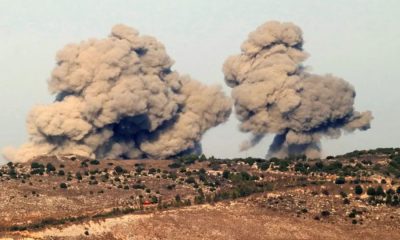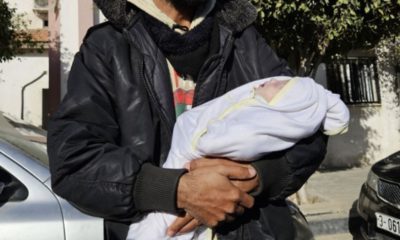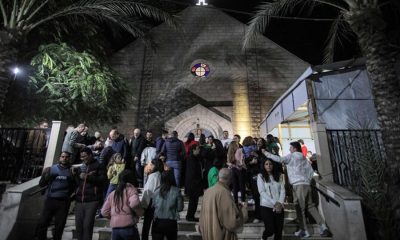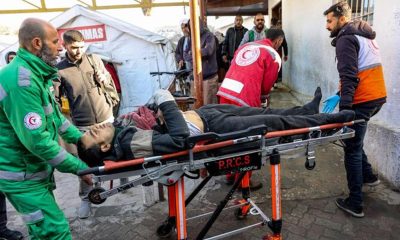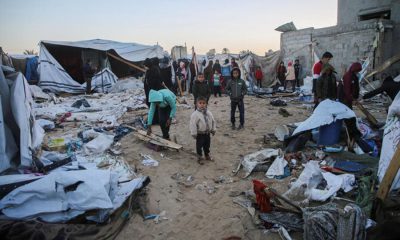International
US weapons used in Israeli attack on Gaza school – Report
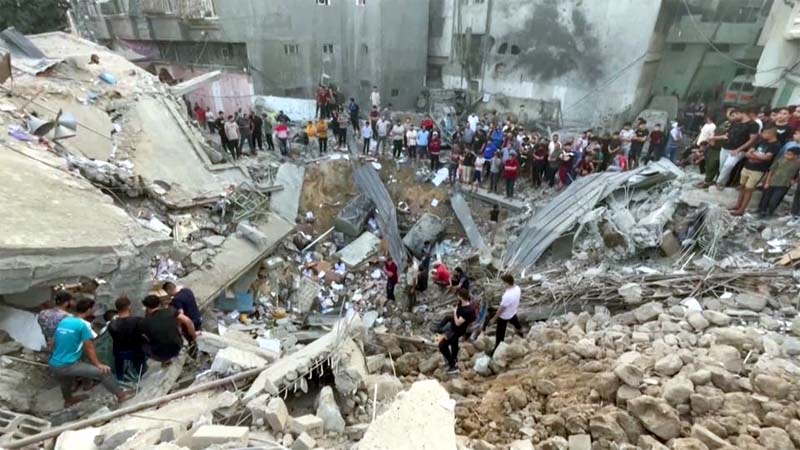
US weapons used in Israeli attack on Gaza school – Report
Among the rubble of the United Nations-run al-Sardi school in central Gaza’s Nuseirat refugee camp were the remnants of the weapons that killed at least 40 Palestinians.
The Israeli attack in the early hours of Thursday gave the displaced people sheltering in the school no prior warning. Fourteen children were killed, as well as nine women and at least 74 other people were wounded. The weapons used to carry out the attack – according to an Al Jazeera analysis of the fragments left behind – were US-made.
An inertial measurement unit from the missile, used to aid with precision targeting, was manufactured by Honeywell, an American conglomerate that specialises in the design and delivery of sensors and guidance devices that are used in a variety of military weapons.
Al Jazeera’s Sanad verification unit discovered that one of the fragments found in Nuseirat bore the manufacturer and category number HG1930BA06, tracing it back to Honeywell. HG1930 refers to the specific sensor manufactured by the company.
The same part was found after the Israeli bombing of a Palestinian home in Shujayea, Gaza in 2014. The two pieces, in the most recent and the 2014 bombing, have the same manufacturer part number inscribed on them.
“We see also other numbers like the MFR, HG 1930 and then BA 06. This is the manufacturer part number that provides more specific details about the component of the missiles,” Elijah Magnier, an independent military and political analyst, told Al Jazeera. “Now, if you look at the manufacturer identification … it is a format used by the aerospace and defence sector in the United States connected to Honeywell.”
READ ALSO:
- CBN will implement bold economic reforms, says Cardoso
- 200 babies born one month in Benue IDP camp – Report
- US sanctions Palestinian group under decree used to target Israeli settlers
“Honeywell is known for the supply of IMU in the various military applications, and particularly the guided missiles that it has been providing to the Israeli Air Force since the year 2000.”
Al Jazeera has reached out to Honeywell for comment, but has yet to receive a response.
Israeli attacks on UN spaces have become commonplace during Israel’s war on Gaza, which has now killed more than 36,000 Palestinians.
The United States has been criticised for its role in supporting Israel, and particularly its continued supply of weapons.
Major rights groups have repeatedly accused Israel of violating international law, and Israel is currently facing a genocide case at the International Court of Justice. The International Criminal Court’s chief prosecutor has also sought arrest warrants for Prime Minister Benjamin Netanyahu and Defence Minister Yoav Gallant for their actions in Gaza.
In May, a US government report found possible Israeli violations of international law in Gaza, but stopped short of identifying the violations that would end its continuing military aid. US President Joe Biden has threatened to stop the supply of some offensive weapons to Israel if it continues its Rafah operation, but has not carried out the threat, despite Israel pressing on in the area, which lies in southern Gaza.
Central Gaza under attack
Central Gaza has most recently come under severe Israeli bombardment, which Palestinians have described as similar to the early days of the war.
The attack on al-Sardi school in Nuseirat is part of that assault.
“The bombardment came from here,” said Naim al-Dadah, a survivor of the attack.
“We were sleeping. The flying metal reached the roof on the other side and all these nets landed over there, on the other side. What happened to us is beyond anyone’s imagination.”
Other witnesses say the attack tore people to pieces. Survivors collected body parts, including those of many children, until the early hours of the morning. Weapon debris was scattered throughout shattered rooms and the blood-stained mattresses. Multiple rooms were targeted, though the building’s structure remained intact.
Israel’s Arabic language spokesperson Avichay Adraee, claimed the UN school was targeted because it housed a Hamas command post and fighters involved in the Palestinian group’s October 7 attack on Israel, which killed 1,139 people. He also claimed Israel took several steps to minimise the possibility of civilian casualties. The director of Hamas’s government media office, Ismail al-Thawabta, rejected Israel’s claims.
In April, the media outlet +972 Magazine reported that Israel uses an artificial intelligence-targeting system called Lavender in its Gaza-bombing campaign. The report quoted Israeli military officials who said that the system generates targets to kill. For low-level Hamas targets, the report said, the army was permitted to kill 15 to 20 civilians. An attack on a more senior Hamas official with the rank of battalion or brigade commander was used to justify the killing of more than 100 civilians.
US weapons used in Israeli attack on Gaza school – Report
SOURCE: AL JAZEERA
International
UN health chief at Yemen airport during Israeli strikes
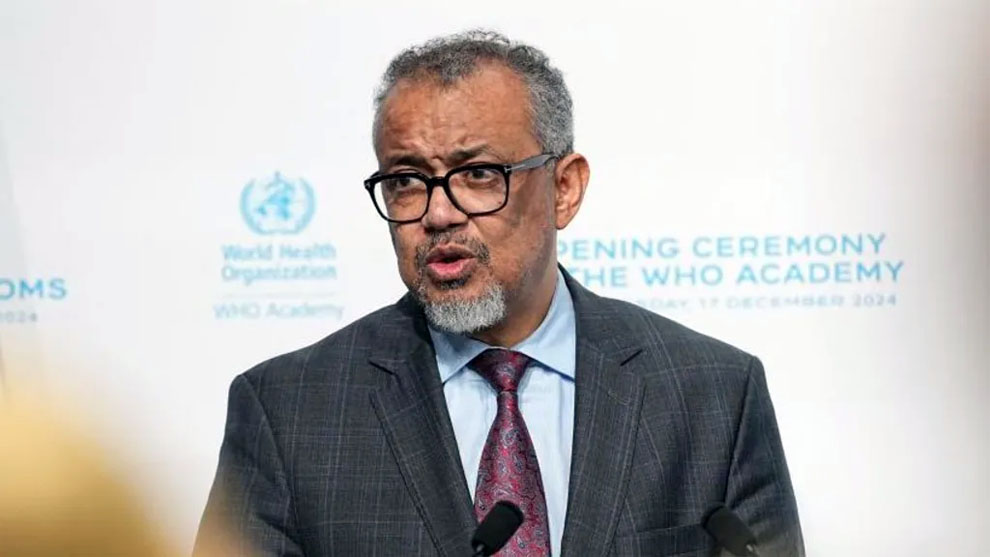
UN health chief at Yemen airport during Israeli strikes
The head of the World Health Organization (WHO) and other UN staff were at Yemen’s international airport in Sanaa on Thursday during Israeli air strikes which are reported to have killed at least six people.
WHO Director General Tedros Adhanom Ghebreyesus said they were about to board a plane when the attacks began.
Houthi-run Saba news agency said three people were killed at the airport and 30 injured. It said another three people were killed and 10 wounded in the western Hodeidah province.
The Iran-backed rebel group described the attacks – which also hit power stations and ports – as “barbaric”. Israel’s military said it carried out “intelligence-based strikes on military targets”.
It is unclear whether the fatalities were civilians or Houthi rebels.
In a statement on X, Dr Tedros said he was in Yemen “to negotiate the release of UN staff detainees and to assess the health and humanitarian situation” in the country. He provided no further details about who the UN detainees were.
Referring to the strikes on Sanaa’s airport, he said: “The air traffic control tower, the departure lounge – just a few meters from where we were – and the runway were damaged.
READ ALSO:
- BREAKING: Adeleke finally pardons ‘fowl thief’ Segun Olowookere
- Five Gaza journalists die in Israeli strike
- Mozambique: Over 1,000 prisoners escape jail as election protests worsen
“We will need to wait for the damage to the airport to be repaired before we can leave,” Dr Tedros added.
UN Secretary General António Guterres called the strikes “especially alarming”.
“I regret the recent escalation between Yemen and Israel, and remain deeply concerned about the risk of further escalation in the region.” he wrote on X.
In a statement, the Israel Defense Forces (IDF) said its “fighter jets conducted intelligence-based strikes on military targets belonging to the Houthi terrorist regime on the western coast and inland Yemen”.
It targeted “military infrastructure” at Sanaa’s airport as well as the Hezyaz and Ras Kanatib power stations, and sites in the Al-Hudaydah, Salif and Ras Kanatib ports on the west coast, the IDF said.
In comments shortly after the strikes, Israel’s Prime Minister Benjamin Netanyahu said it would “continue to cut off the terror arm of the Iranian axis of evil until we complete the job”, adding “we are only just starting with [the Houthis]”.
Early on Friday, the IDF reported that one missile fired from Yemen was intercepted before crossing into Israeli territory.
Mohammed Ali al-Houthi, head of the Houthis’ supreme revolutionary committee, called Thursday’s strikes on Yemen “barbaric” and “aggressive”.
He said that “confrontations with American and Israeli arrogance” will continue until the conflict in Gaza stops.
Several people injured by the strikes at the airport in Sanaa told Houthi-run broadcaster Al Masirah that the runway was struck three times before the airport’s control tower was also hit.
One man, who identified himself as Dr Abbas Rajeh, said the police hospital he works in treated 10 patients after the attacks – one had already died, another was in critical condition, and others had minor injuries or broken bones.
Iran described the strikes as a “clear violation of international peace and security”.
Houthi rebels have been attacking Israel since the first months of the Gaza war, which began in October 2023.
A Houthi missile strike injured more than a dozen people in Israel last week.
Israel has carried out intermittent strikes against Houthis in retaliation.
Earlier this week, Israel’s defence minister said the country was preparing to “strike hard” at the Houthis, warning it would “decapitate” the group’s leadership.
The Houthis are an armed political and religious group backed by Iran. The group has ruled large parts of western Yemen, including the capital Sanaa, since ousting the internationally recognised government in 2015.
UN health chief at Yemen airport during Israeli strikes
BBC
International
Baby freezes to death overnight in Gaza as ceasefire delays
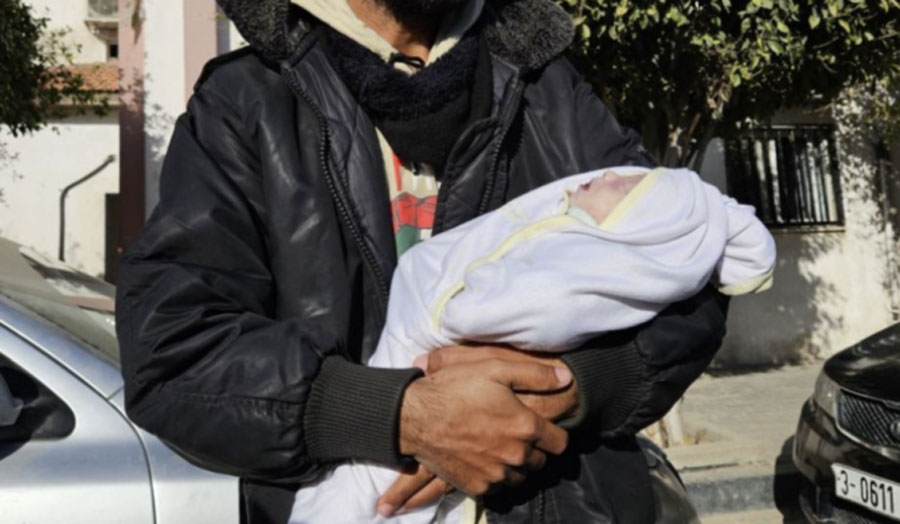
Baby freezes to death overnight in Gaza as ceasefire delays
JERUSALEM: A baby girl froze to death overnight in Gaza, while Israel and Hamas accused each other of complicating ceasefire efforts that could wind down the 14-month war.
The 3-week old baby was the third to die from the cold in Gaza’s tent camps in recent days, doctors said, deaths that underscore the squalid conditions, with hundreds of thousands of Palestinians crammed into often ramshackle tents after fleeing Israeli offensives.
Israel’s bombardment and ground invasion of Gaza has killed over 45,000 Palestinians, more than half of them women and children, according to Gaza’s Health Ministry.
The offensive has caused widespread destruction and displaced some 90 percent of Gaza’s 2.3 million people, often multiple times. Hundreds of thousands are packed into tent camps along the coast as the cold, wet winter sets in. Aid groups have struggled to deliver food and supplies and say there are shortages of blankets, warm clothing and firewood.
Israel has increased the amount of aid it allows into the territory, reaching an average of 130 trucks a day so far this month, up from around 70 a day in October and November. Still, the amount remains well below than previous months and the United Nations says it is unable to distribute more than half the aid because Israeli forces deny permission to move within Gaza or because of rampant lawlessness and theft from trucks.
READ ALSO:
- I was not removed by Tinubu – Ex-Women Affairs minister [VIDEO]
- Ghanaian president approves visa-free entry for all Africans
- Waiting for palliative: Ndume shares on X video of long queues outside Tinubu’s Lagos residence
The father of 3-week-old Sila, Mahmoud Al-Faseeh, wrapped her in a blanket to try and keep her warm in their tent in the Muwasi area outside the town of Khan Younis, but it wasn’t enough, he told The Associated Press. He said the tent was not sealed from the wind and the ground was cold, as temperatures on Tuesday night dropped to 9 degrees Celsius (48 degrees Fahrenheit.) Muwasi is a desolate area of dunes and farmland on Gaza’s Mediterranean coast.
“It was very cold overnight and as adults we couldn’t even take it. We couldn’t stay warm,” he said. Sila woke up crying three times overnight and in the morning they found her unresponsive, her body stiff.
“She was like wood,” said Al-Faseeh. They rushed her to a field hospital where doctors tried to revive her, but her lungs had already deteriorated. Images of Sila taken by the AP showed the little girl with purple lips, her pale skin blotchy.
Ahmed Al-Farra, director of the children’s ward at Nasser Hospital in Khan Younis, confirmed that the baby died of hypothermia. He said two other babies — one 3 days old, the other a month old — had been brought to the hospital over the past 48 hours after dying of hypothermia.
Meanwhile, hopes for a ceasefire looked complicated Wednesday, with Israel and the militant Hamas group that runs Gaza trading accusations of delaying an agreement. In recent weeks, the two sides appeared to be inching toward a deal that would bring home dozens of hostages held by the militants in Gaza, but differences have emerged.
Although Israel and Hamas have expressed optimism that progress was being made toward a deal, sticking points remain over the exchange of hostages for Palestinian prisoners and the withdrawal of Israeli troops from Gaza, people involved in the talks say.
On Wednesday, Hamas accused Israel of introducing new conditions related to the withdrawal from Gaza, the prisoners and the return of displaced people, which it said was delaying the deal.
Israel’s government accused Hamas of reneging on understandings that have already been reached.” Still, both sides said discussions are ongoing.
Israel’s negotiating team, which includes members from its intelligence agencies and the military, returned from Qatar on Tuesday evening for internal consultations, following a week of what it called “significant negotiations.”
During its Oct. 7, 2023, attack on southern Israel, Hamas and other groups took about 250 people hostages and brought them to Gaza. A previous truce in November 2023 freed more than 100 hostages, while others have been rescued or their remains have been recovered over the past year.
Israel says about 100 hostages remain in Gaza — at least a third whom it believes were killed during the Oct. 7 attack or died in captivity.
Sporadic talks have taken place for a year, but in recent weeks there’s been a renewed push to reach a deal.
President-elect Donald Trump, who takes office next month for his second term, has demanded the immediate release of Israeli hostages, saying on social media that if they’re not freed before he is sworn in, there will be “HELL TO PAY.”
Families of the hostages are becoming increasingly angry, calling on the Israeli government for a ceasefire before Trump is sworn in.
After Israel’s high-level negotiation team returned from Doha this week, hostage families called an emergency press conference in Tel Aviv, Israel, pleading for a ceasefire and a complete end to the war.
Shir Siegel, the daughter of Israeli-American Keith Siegel, whose mother was released after more than 50 days in captivity, said every delay could endanger their lives. “There are moments when every second is fateful, and this is one of those moments,” she said.
Families of the hostages marked the first night of Hannukah with a candle lighting ceremony in Tel Aviv as well as by the Western Wall in Jerusalem.
The agreement would take effect in phases and include a halt in fighting, an exchange of Israeli hostages for Palestinian prisoners, and a surge in aid to the besieged Gaza, according to Egyptian, Hamas and American officials. The last phase would include the release of any remaining hostages, an end to the war and talks on reconstruction.
Baby freezes to death overnight in Gaza as ceasefire delays
ARAB NEWS
International
At least 10 killed in Israeli strikes on Gaza
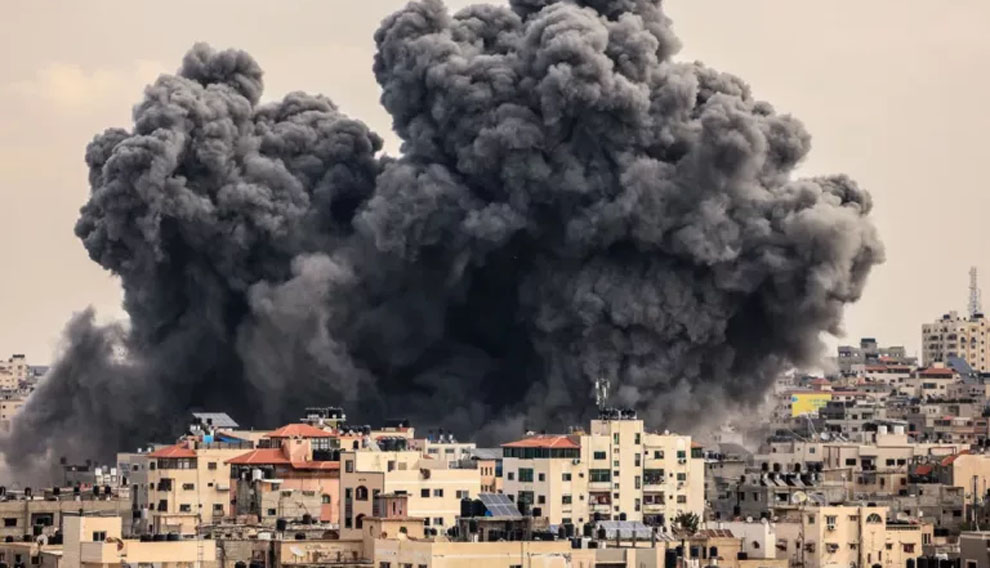
At least 10 killed in Israeli strikes on Gaza
At least 10 people were killed and more than a dozen wounded in Israeli strikes on Gaza early on Thursday, medics with the Gaza health authorities said.
Five people were killed and 20 wounded in an Israeli airstrike on a house in Gaza City’s Zeitoun neighborhood, the medics reported. They warned the death toll could rise as many remained trapped under the rubble.
In a separate incident, five journalists were killed when their vehicle was struck in the vicinity of Al-Awda hospital in Nuseirat in central Gaza, the enclave’s health authorities said. The journalists worked for the Al-Quds Al-Youm television channel.
READ ALSO:
- I was not removed by Tinubu – Ex-Women Affairs minister [VIDEO]
- Ghanaian president approves visa-free entry for all Africans
- Waiting for palliative: Ndume shares on X video of long queues outside Tinubu’s Lagos residence
Palestinian media and local reporters said the vehicle was marked as a media van and was used by journalists to report from inside the hospital and Nuseirat camp.
There was no immediate Israeli comment on the reported strikes.
On Wednesday, Palestinian militant group Hamas and Israel traded blame over their failure to conclude a ceasefire agreement despite progress reported by both sides in past days.
At least 10 killed in Israeli strikes on Gaza
ARAB NEWS
-

 metro3 days ago
metro3 days agoINTERPOL declares 14 Nigerians wanted for drug, human trafficking
-

 metro1 day ago
metro1 day agoJigawa State governor loses son 24 hours after mother’s death
-

 metro3 days ago
metro3 days agoIbadan stampede: She was treated like a terrorist, Queen Naomi’s sister says about her condition
-

 Business3 days ago
Business3 days agoNNPCL launches production monitoring centre
-

 Business2 days ago
Business2 days agoBe creative, monarch, others challenge Muslim professionals on economic revival
-

 Entertainment21 hours ago
Entertainment21 hours agoMultiChoice announces free access to all DSTV channels for 3 days
-

 metro15 hours ago
metro15 hours agoHeavy security in Ilesa as ex-Osun deputy gov emerges new Owa-Obokun
-
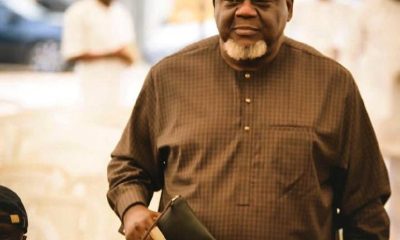
 Auto17 hours ago
Auto17 hours agoLSM MD extols founder’s qualities after latter posthumous industry award

